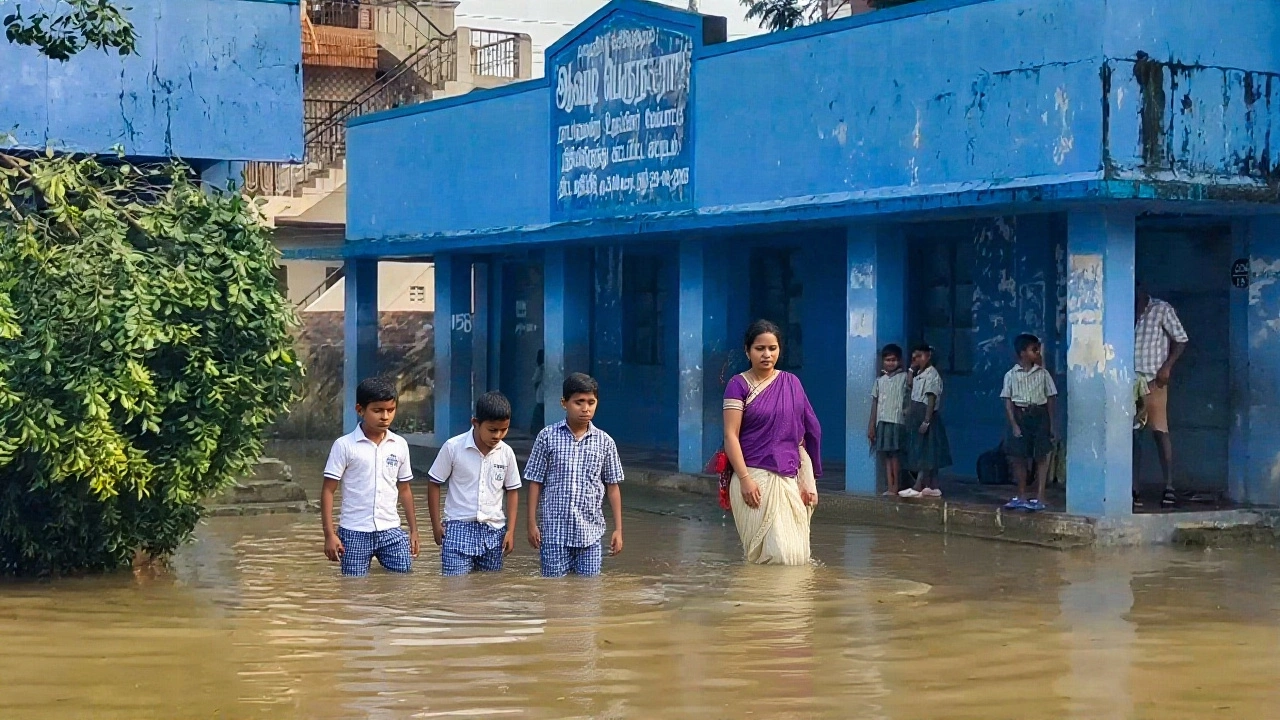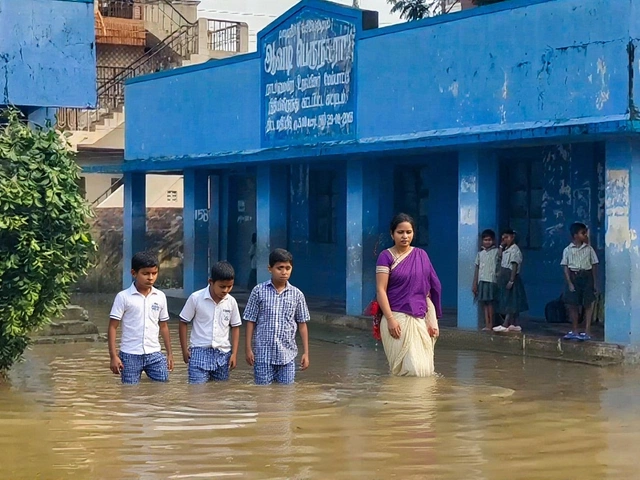When the rain started pounding Chennai’s streets on the morning of November 17, 2025, parents didn’t just worry about wet umbrellas—they worried about whether their kids would make it to school at all. By midday, Chengalpattu and Nagapattinam districts had already shut all schools. In Karaikal, even private colleges closed their gates. The reason? A stubborn low-pressure system over the Bay of Bengal had dumped over 120 mm of rain in just 12 hours, turning roads into rivers and flooding school grounds. The India Meteorological Department (IMD) had issued an orange alert at 11:27 IST that same morning, but for many families, the warning came too late—some kids were already halfway to school when the calls went out.
Who Decided What—and Why?
It wasn’t a statewide order. Each district collector acted independently, based on real-time water levels and road conditions. In Nagapattinam, District Collector Akash didn’t wait for a higher directive. He saw flooded playgrounds and water rising past the knees in school parking lots. "It’s not about damaged buildings," he told reporters. "It’s about getting children home safely. If the road’s underwater, the school stays closed." His decision echoed in Puducherry and Karaikal, where local authorities cited the same logic: safety over schedule.But here’s the twist: while most districts moved fast, Chennai sent mixed signals. The Times of India reported at 11:27 IST that schools in "Chennai and North TN" remained open—despite the IMD’s alert. Yet within hours, Hearinguru and Times Now News confirmed closures in the same area. Why the contradiction? Officials later admitted: some schools in southern Chennai, like those in Thiruvallur and Kancheepuram, were still open because water hadn’t reached critical levels yet. But by 4 p.m., even those districts began issuing advisories. The confusion? Purely logistical. No central command. Just 30+ district offices making snap calls.
The Weather Behind the Chaos
The low-pressure system isn’t a one-day storm. It’s part of a slow-moving weather pattern that’s been lingering since November 15, 2025, drawing moisture from the Bay of Bengal like a sponge. The IMD predicted 100–150 mm of rain across 12 districts by November 18, with isolated pockets seeing over 200 mm. That’s more than half the average monthly rainfall for November in some areas. CollegeDekho’s analysis showed that eight districts—Thiruvallur, Kancheepuram, Chennai, Chengalpattu, Mayiladuthurai, Nagapattinam, Thiruvarur, and Karaikal—had a 60–70% chance of closures on the 18th. Another 22 districts, including Tirunelveli and Ramanathapuram, were watching closely, with a 30–40% chance.What’s unusual is that Tamil Nadu is the only state making these calls. Neighboring Andhra Pradesh and Kerala, despite similar rainfall, kept schools open. "It’s a cultural thing," said Dr. Priya Nair, a disaster management expert at Anna University. "In Tamil Nadu, there’s deep institutional trust in district collectors. They’re empowered to act. In other states, bureaucracy slows things down. By the time they decide, the damage is done."
What’s Really at Stake
It’s not just about missed lessons. Parents in Chengalpattu reported that buses were stranded, auto-rickshaws refused to run, and some children walked through waist-deep water to reach school before closures were announced. One mother in Thiruvallur told a local news channel: "My daughter came home soaked. Her books were ruined. She cried. I cried. We spent two hours waiting for a taxi that never came."And while school buildings themselves are mostly intact—"It’s not structural damage," as officials stressed—the real risk is exposure. Floodwaters carry sewage, debris, and electrical hazards. Children, especially those under 10, are more vulnerable to waterborne illnesses. The state health department quietly activated mobile clinics in 15 flood-prone blocks, just in case.
What Happens Next?
By November 18, 2025, the system is expected to weaken slightly—but not disappear. Rainfall will taper to 50–80 mm in most districts, but the ground is already saturated. That means even light showers could trigger new floods. District collectors are holding emergency meetings at 7 a.m. daily. Some, like in Nagapattinam, have already announced that schools will remain closed on the 19th too. Others are waiting to see if the IMD downgrades the alert.Meanwhile, the state education department is quietly drafting a new policy: a standardized weather-triggered closure protocol. Right now, it’s a patchwork. One district closes at 8 a.m. Another waits until noon. A third waits for a district collector’s signature. "We need a rulebook," said a senior official who spoke anonymously. "Not because we don’t trust our collectors—but because parents deserve clarity."
Why This Matters Beyond Tamil Nadu
This isn’t just a weather story. It’s a test case for how local governance responds to climate volatility. In 2023, Chennai’s floods cost the state over ₹1,200 crore in lost productivity. This year, schools are the first line of defense—not because they’re fragile, but because children are. The fact that 30 districts are making independent calls, based on real-time data, shows a shift: decentralized, responsive governance. But it also reveals a gap: no unified alert system for parents. No single app. No SMS blast. Just WhatsApp groups and local radio.And that’s the real lesson here: when the rain comes, we rely on human judgment. Not algorithms. Not apps. People like Akash in Nagapattinam, making calls at 6 a.m. with a cup of coffee and a raincoat, deciding what’s safer: a lesson, or a life.
Frequently Asked Questions
Which districts had confirmed school closures on November 17, 2025?
Confirmed closures on November 17, 2025, included Nagapattinam, Karaikal, Puducherry, Chengalpattu, Thiruvallur, Kancheepuram, and parts of Chennai. District collectors in these areas acted on IMD orange alerts and visible waterlogging. Private and government schools alike shut down, even where infrastructure was undamaged, to prevent student exposure to flood risks.
Why did The Times of India say schools were open while others reported closures?
The discrepancy stemmed from timing and reporting scope. The Times of India’s report at 11:27 IST was based on early morning data, before district-level decisions were fully implemented. By afternoon, multiple districts had issued closures, and later reports from Hearinguru and Times Now News reflected the updated ground reality. Local variations in rainfall intensity also meant some schools remained open longer than others.
Are school closures mandatory or just advisories?
In Tamil Nadu, school closures during extreme weather are legally binding orders issued by district collectors under the Disaster Management Act, 2005. They’re not advisories. Parents who send children to closed schools risk liability if accidents occur. Teachers are required to stay home unless assigned to emergency response duties. The state enforces these orders uniformly once issued.
How are parents being informed about closures?
There’s no centralized system. Notifications come through district education department websites, local radio stations, WhatsApp groups managed by school PTAs, and SMS alerts from some municipal corporations. Many parents rely on social media or neighbor networks. The lack of a unified alert platform has been criticized by education unions, who are pushing for an integrated state-wide system linked to IMD forecasts.
Will schools make up for lost days?
Yes, but not uniformly. Most districts plan to extend the academic calendar by 3–5 days, typically using Saturdays in January and February. Some schools in less-affected areas may offer weekend classes. The Tamil Nadu State Board has not mandated a uniform make-up policy, leaving decisions to individual districts. This means students in Chennai might return to school on Saturdays while those in Theni do not.
What’s different about this rainfall compared to past years?
This event is notable for its intensity and timing. Rainfall of 100–150 mm in 24 hours is rare in mid-November; typically, heavy rain occurs in October or December. Climate scientists point to warmer Bay of Bengal surface temperatures—up 1.8°C above average this year—as a contributing factor. The IMD has noted a 40% increase in such extreme rainfall events in Tamil Nadu since 2018, making these closures more frequent and harder to predict.


